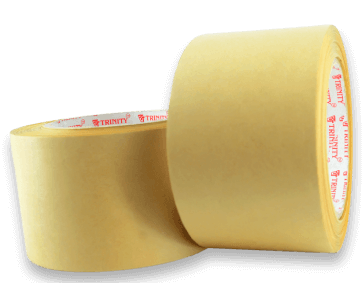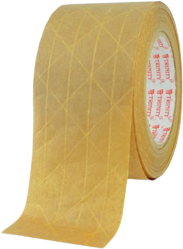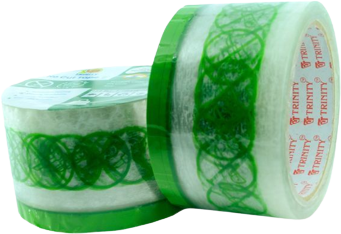Introducing our new eco-friendly tapes, a big leap in green innovation. These tapes not only work great but also help the environment. We've made them with advanced materials and eco-friendly methods to give you a reliable option for sticking things together.
Let's move towards a greener future together with tapes that support both your needs and the planet.

Good adhesion on different cardboard qualities
Can be torn by hand
Suitable for manual and automatic dispensers

Good adhesion on different cardboard qualities.
Can be torn by hand.
Suitable for manual and automatic dispensers.

High tensile strength.
Good adhesion on different cardboard qualities.
Suitable for manual and automatic dispensers.
Made from renewable and biodegradable paper.

No knives or scissors needed to remove the tape from box.
Good adhesion on different cardboard qualities.
Convestional tape with revolutionary addition.
Can be used in normal BOPP tape dispensers.
Are you wondering why your business should invest in sustainable packaging? Well, let me tell you, these environmentally-friendly packaging solutions serve a critical purpose: safeguarding the world's ecosystems, thereby ensuring the long-term quality and viability of human life. But that's not all; there are numerous other advantages that come with it:
Linerless label features adhesive on its underside and silicone on the upper side. It presents a pliable and eco-friendly substitute for traditional pressure-sensitive labeling components, while retaining identical scanning and traceability characteristics.
Linerless label proves highly suitable for various uses including retail, food, and logistics labeling. It also excels in scenarios demanding excellent thermal printability and adhesion, coupled with a neat and precise cutting process.


Trinity Linerless labels are designed for demanding conditions.
They are available in all main core sizes.
Enhance operational uptime, decrease the frequency of roll replacements, and minimize storage requirements with the potential for up to seventy-five percent more linear meters per roll. Furthermore, these labels retain equivalent scanning and traceability characteristics as labels with liners, all while utilizing fewer raw materials. This translates to heightened shipping efficiency without any compromise on performance.
Trinity Linerless labels offer the flexibility of being cut to any desired length, leading to reduced material expenses by eliminating the necessity to stock a range of different sizes and streamlining stock-keeping units. The utilization of linerless materials also eliminates the need for managing and processing liner waste disposal.
Various products necessitate distinct label sizes to fulfill diverse information prerequisites. The demand for sizes can fluctuate even up to the printing stage. Linerless labels offer a versatile solution by being customizable to any length, eradicating the necessity of upkeeping label inventories with assorted sizes.
Trinity labels are sourced from Linerless certified origins that have demonstrated a beneficial influence on forests and their role in promoting overall well-being. Additionally, these labels employ approximately 40% less paper than comparable pressure-sensitive label materials that include liners, thereby minimizing costs associated with handling liner waste. The procurement of materials from sustainably managed forests safeguards wildlife, aids in mitigating climate change, and enhances water quality.
Adhesion
refers to the attraction between different substances or surfaces, causing them to stick together. It is a result of intermolecular forces that operate within a distance of up to 10-5mm between surfaces. Interestingly, even seemingly smooth surfaces appear jagged under a microscope. When adhesive (glue) fills in these gaps, it optimizes the contact area between the surfaces, leading to maximum adhesion forces.
Cohesion
on the other hand, is the tendency of similar substances or surfaces to stick to each other, representing the "inner strength" of an adhesive. It arises from cohesive forces and determines the adhesive's strength when subjected to stress or load. Adhesion and cohesion are interconnected: generally, the harder an adhesive is, the higher its cohesion and the lower its adhesion, and vice versa. By modifying the formulation of the adhesive, various cohesive and adhesive properties can be achieved, resulting in both harder and softer adhesive products.
Peel and shear forces play the most significant roles in impacting the adhesive bond when it comes to adhesive tape.
Peel forces act on the bond at an angle greater than 0°. A practical example illustrating peel forces is peeling adhesive tape off a cardboard box by hand.
Shear force refers to the bond's resistance against forces parallel to its application direction. This force ensures that a packaging tape securely holds the flaps of a cardboard box under static or dynamic loads.
Cohesive failure is indicated by adhesive residue remaining on the substrate surface. This suggests that the "inner strength" of the adhesive was not sufficient, leading to the adhesive itself failing. In some cases, this type of failure might be a desired technical feature, like in surface protection applications, where clean removal (adhesion failure) is preferred. However, in tasks like using "security tape" for tamper-evident carton closure, cohesive failure resulting in adhesive residue on the surface indicates potential unauthorized access.
Adhesion failure, on the other hand, shows that the "inner strength" of the adhesive is greater than the adhesive bond with the surface. This results in a clean surface without adhesive residue. Like cohesive failure, adhesion failure may also imply that the chosen adhesive tape is not suitable for the specific application or could be due to a product defect.
Selecting the right adhesive tape that matches the requirements of the task is crucial in ensuring successful bonding without compromising performance.
When applying self-adhesive tapes on a carton, it's crucial to maintain steady application pressure. Inadequate pressure can lead to the tape lifting from the carton surface, causing the carton to open.
If you're using a tape dispenser, ensure that the track is positioned close to the carton, allowing the tape to be affixed with the pressure flap along the entire length and front sides of the carton. When employing a carton closing machine, the tape will automatically apply with consistent pressure.
To prevent damage to the tape roll, refrain from using sharp or pointed objects to open cartons or plastic shrink wrap. Our boxes feature a convenient push-and-pull perforation, enabling easy opening. Additionally, it's important to store both adhesive tape and cartons at room temperature for optimal performance.
Self-adhesive packaging tapes have specific characteristics and chemical composition that require careful storage considerations. Extreme temperatures, whether high in summer or sub-zero in winter, can impact the tape even within closed cartons. Improper storage can lead to changes in the tape's properties: the roll of adhesive tape may deform, and the adhesive's characteristics might alter, resulting in embrittlement and reduced adhesion.
For optimal handling and performance, we recommend storing self-adhesive tapes in their original packaging in a dry, dark environment, maintaining a temperature between 15°C and 25°C. By adhering to these storage guidelines, the tape will retain its original characteristics, ensuring smooth and problem-free usage.
Live test the caliber of our products


Let us contact you to understand your requirements and deliver sample the product of your choice.
